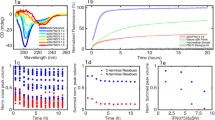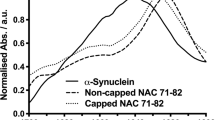Abstract
NACP, the precursor protein of the non-amyloid β/A4 protein (Aβ) component of Alzheimer's disease (AD) amyloid, also known as α-synuclein was shown to undergo self-oligomerization only in the presence of a modified Aβ fragment (residues 25–35) by using a relatively hydrophobic coupling reagent, dicyclohexylcarbodiimide (DCCD). Since the oligomerization not only required a relatively high concentration of DCCD but also its efficiency was suppressed even at a slightly basic pH of 7.5, another coupling reagent called N-(ethoxycarbonyl)-2-ethoxy-1,2-dihydroquinoline (EEDQ) was examined in order to make use of this technique to access the functional aspects of NACP in vitro by exploring more accurate and reproducible reaction conditions. The EEDQ also gave rise to the NACP oligomerization only in the presence of Aβ25-35 among the variously modified Aβ peptides. The reagent was about three times more effective than DCCD in terms of its optimal concentration to visualize the oligomers. In addition, its oligomerizing potency was not affected by the basic condition. Although physiological and pathological significance of the NACP self-oligomerization are currently unknown, this dramatic phenomenon and its visualization technique could shed light on the determination of molecular relationships of NACP with various intracellular or extracellular biomolecules related to the pathological conditions of Alzheimer's and Parkinson's diseases.
Similar content being viewed by others
REFERENCES
Ueda, K., Fukushima, H., Masliah, E., Xia, Y., Iwai, A., Yoshimoto, M., Otero, D. A. C., Kondo, J., Ihara, Y., and Saitoh, T. 1993. Molecular cloning of cDNA encoding an unrecognized component of amyloid in Alzheimer's disease. Proc. Natl. Acad. Sci. USA 90:11282-11286.
Iwai, A., Masliah, E., Yoshimoto, M., Ge, N., Flanagan, L., Rohan de Silva, H. A., Kittel, A., and Saitoh, T. 1995. The precursor protein of non-Aβ component of Alzheimer's disease amyloid is a presynaptic protein of the central nervous system. Neuron 14:467-475.
Jakes, R., Spillantini, M. G., and Goedert, M. 1994. Identification of two distinct synucleins from human brain. FEBS Lett. 345:27-32.
Maroteaux, L., Campanelli, J. T., and Scheller, R. H. 1988. Synuclein: a neuron-specific protein localized to the nucleus and presynaptic nerve terminal. J. Neurosci. 8:2804-2815.
Maroteaux, L., and Scheller, R. H. 1991. The rat brain synucleins; family of proteins transiently associated with neuronal membrane. Mol. Brain Res. 11:335-343.
Nakajo, S., Omata, K., Aiuchi, T., Shibayama, T., Okahashi, I., Ochiai, H., Nakai, Y., Nakaya, K., and Nakamura, Y. 1990. Purification and characterization of a novel brain-specific 14-kDa protein. J. Neurochem. 55:2031-2038.
Nakajo, S., Shioda, S., Nakai, Y., and Nakaya, K. 1994. Localization of phosphoneuroprotein 14 (PNP 14) and its mRNA expression in rat brain determined by immunocytochemistry and in situ hybridization. Mol. Brain Res. 27:81-86.
George, J. M., Jim, H., Woods, W. S., and Clayton, D. F. 1995. Characterization of a novel protein regulated during the critical period for song learning in the zebra finch. Neuron 15:361-372.
Ueda, K., Saitoh, T., and Mori, H. 1994. Tissue-dependent alternative splicing of mRNA for NACP, the precursor of non-Aβ component of Alzheimer's disease amyloid. Biochem. Biophys. Res. Commun. 205:1366-1372.
Brookes, A.J., and St Clair, D. 1994. Synuclein proteins and Alzheimer's disease. Trends Neurosci. 17:404-405.
Heintz, N., and Zoghbi, H. 1997. α-synuclein—a link between Parkinson and Alzheimer diseases? Nat. Genet. 16:325-327.
Goedert, M. 1997. The awakening of α-synuclein. Nature 388:232-233.
Spillantini, M. G., Schmidt, M. L., Lee, V. M.-Y., Trojanowski, J. Q., Jakes, R., and Goedert, M. 1997. α-synuclein in Lewy bodies. Nature 388:839-840.
Han, H., Weinreb, P.H., and Lansbury, P. T., Jr. 1995. The core Alzheimer's peptide NAC forms amyloid fibrils which seed and are seeded by β-amyloid: is NAC a common trigger or target in neurodegenerative disease? Chem. Biol. 2:163-169.
Iwai, A., Yoshimoto, M., Masliah, E., and Saitoh, T. 1995. Non-Aβ component of Alzheimer's disease amyloid (NAC) is amyloidogenic. Biochemistry 34:10139-10145.
Haass, C., Schlossmacher, M. G., Hung, A. Y., Vigo-Pelfrey, C., Mellon, A., Ostaszewski, B. L., Lieberberg, I., Koo, E. H., Schenk, D., Teplow, D. B., and Selkoe, D. J. 1992. Amyloid β-peptide is produced by cultured cells during normal metabolism. Nature 359:322-325.
Seubert, P., Vigo-Pelfrey, C., Esch, F., Lee, M., Dovey, H., Davis, D., Sinha, S., Schlossmacher, M., Whaley, J., Swindlehurst, C., McCormack, R., Wolfert, R., Selkoe, D., Lieberburg, I., and Schenk, D. 1992. Isolation and quantification of soluble Alzheimer's β-peptide from biological fluids. Nature 359:325-327.
Shoji, M., Golde, T. E., Ghiso, J., Cheung, T. T., Estus, S., Shaffer, L. M., Cai, X.-D., McKay, D. M., Tintner, R., Frangione, B., and Younkin, S. G. 1992. Production of the Alzheimer amyloid protein by normal proteolytic processing. Science 258:126-129.
Busciglio, J., Gabuxda, D. H., Matsudaira, P., and Yankner, B. A. 1993. Generation of β-amyloid in the secretory pathway in neuronal and nonneuronal cells. Proc. Natl. Acad. Sci. USA 90:2092-2096.
Yoshimoto, M., Iwai, A., Kang, D., Otero, D. A. C., Xia, Y., and Saitoh, T. 1995. NACP, the precursor protein of the non-amyloid β/A4 protein (Aβ) component of Alzheimer disease amyloid, binds Aβ and stimulates Aβ aggregation. Proc. Natl. Acad. Sci. USA 92:9141-9145.
Vogel, G. 1997. Gene discovery offers tentative clues to Parkinson's. Science 276:1973.
Polymeropoulos, M. H., Lavedan, C., Leroy, E., Ide, S. E., Dehejia, A., Dutra, A., Pike, B., Root, H., Rubenstein, J., Boyer, R., Stenroos, E. S., Chandrasekharappa, S., Athanassiadou, A., Papapetropoulos, T., Johnson, W. G., Lassarini, A. M., Duvoisin, R. C., Iorio, G. D., Golbe, L. I., and Nussbaum, R. L. 1997. Mutation in the-synuclein gene identified in families with Parkinson's disease. Science 276:2045-2047.
Weinreb, P. H., Zhen, W., Poon, A. W., Conway, K. A., and Lansbury, P. T., Jr. 1996. NACP, a protein implicated in Alzheimer's disease and learning is natively unfolded. Biochemistry 35:13709-13715.
Kim, J. 1997. Evidence that the precursor protein of non-Aβ component of Alzheimer's disease amyloid (NACP) has an extended structure primarily composed of random-coil. Mol. Cells 7:78-83.
Paik, S.R., Lee, J.-H., Kim, D.-H., Chang, C.-S., Kim, Y.-S. 1998. Self-oligomerization of NACP, the precursor protein of the nonamyloid β/A4 protein (Aβ) component of Alzheimer's disease amyloid, observed in the presence of a C-terminal Aβ fragment (residues 25–35). FEBS Lett. 421:73-76.
Paik, S. R., Lee, J.-H., Kim, D.-H., Chang, C.-S., Kim, J. 1997. Aluminum-induced structural alterations of the precusor of the non-Aβ component of Alzheimer's disease amyloid. Arch. Biochem. Biophys. 344:325-334.
Morrissey, J. H. 1981. Silver stain for proteins in polyacrylamide gels: A modified procedure with enhanced uniform sensitivity. Anal. Biochem. 117:307-310.
Yankner, B. A., Duffy, L. K., Kirschner, D. A. 1990. Neurotrophic and neurotoxic effects of Amyloid β protein: Reversal by tachykinin neuropeptides. Science 250:279-282.
Azzi, A., Casey, R. P., and Nalecz, M. J. 1984. The effect of N′,N′-dicyclohexylcarbodiimide on enzymes of bioenergetic relevance. Biochim. Biophys. Acta 768:209-226.
Laikind, P. K., Hill, F. C., and Allison, W. S. 1985. The use of [3H]aniline to identify the essential carboxyl group in the bovine mitochondrial F1-ATPase that reacts with 1-(ethoxycarbonyl)-2-ethoxy-1,2-dihydroquinoline. Arch. Biochem. Biophys. 240:904-920.
Author information
Authors and Affiliations
Rights and permissions
About this article
Cite this article
Lee, JH., Shin, HJ., Chang, CS. et al. Comparisons of the NACP Self-Oligomerizations Induced by Aβ25-35 in the Presence of Dicyclohexylcarbodiimide and N-(Ethoxycarbonyl)-2-Ethoxy-1,2-Dihydroquinoline. Neurochem Res 23, 1427–1434 (1998). https://doi.org/10.1023/A:1020711025418
Issue Date:
DOI: https://doi.org/10.1023/A:1020711025418




